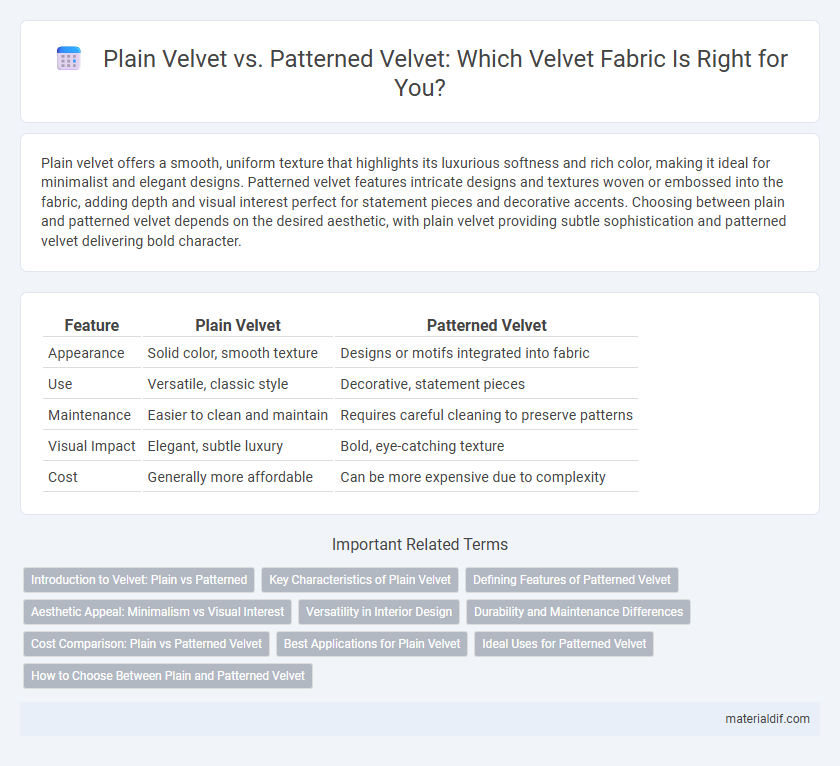Plain velvet offers a smooth, uniform texture that highlights its luxurious softness and rich color, making it ideal for minimalist and elegant designs. Patterned velvet features intricate designs and textures woven or embossed into the fabric, adding depth and visual interest perfect for statement pieces and decorative accents. Choosing between plain and patterned velvet depends on the desired aesthetic, with plain velvet providing subtle sophistication and patterned velvet delivering bold character.
Table of Comparison
| Feature | Plain Velvet | Patterned Velvet |
|---|---|---|
| Appearance | Solid color, smooth texture | Designs or motifs integrated into fabric |
| Use | Versatile, classic style | Decorative, statement pieces |
| Maintenance | Easier to clean and maintain | Requires careful cleaning to preserve patterns |
| Visual Impact | Elegant, subtle luxury | Bold, eye-catching texture |
| Cost | Generally more affordable | Can be more expensive due to complexity |
Introduction to Velvet: Plain vs Patterned
Velvet is a luxurious fabric known for its soft texture and rich appearance, available in two main varieties: plain and patterned. Plain velvet showcases a smooth, uniform surface that highlights its dense pile and vibrant colors, ideal for minimalist and elegant designs. Patterned velvet incorporates raised designs through embossing or weaving techniques, adding depth and visual interest for more decorative and ornate applications.
Key Characteristics of Plain Velvet
Plain velvet features a smooth, uniform surface with a rich, plush texture that enhances its luxurious feel and appearance. Its consistent color and sleek finish make it versatile for upholstery, fashion, and accessories, providing a timeless elegance without visual distractions. The dense pile of plain velvet reflects light evenly, creating a subtle sheen that highlights its depth and softness.
Defining Features of Patterned Velvet
Patterned velvet is characterized by its intricate designs woven or embossed directly into the fabric, offering a textured surface that contrasts the smooth, uniform appearance of plain velvet. This type of velvet often incorporates motifs such as florals, geometrics, or damask patterns, enhancing its decorative appeal and depth. Typically crafted through techniques like devore or burnout, patterned velvet provides a luxurious and visually dynamic fabric choice for upholstery, fashion, and interior decor.
Aesthetic Appeal: Minimalism vs Visual Interest
Plain velvet offers a sleek, minimalist aesthetic that emphasizes texture and richness through uniform color, enhancing modern and understated interior designs. Patterned velvet introduces intricate designs and variations in color, creating visual interest and dynamic focal points ideal for eclectic or opulent decor. The choice between plain and patterned velvet significantly influences the overall mood, either reinforcing simplicity or celebrating decorative complexity.
Versatility in Interior Design
Plain velvet offers timeless elegance and a neutral canvas that complements diverse interior styles, making it ideal for versatile applications in upholstery, drapery, and cushions. Patterned velvet introduces texture and visual interest, lending character to statement pieces while enhancing the depth and warmth of a space. Both types adapt seamlessly to modern, classic, and eclectic designs, allowing designers to balance subtlety and boldness in interior decor.
Durability and Maintenance Differences
Plain velvet typically offers greater durability due to its uniform texture, which resists wear and tear more effectively than the intricate designs found in patterned velvet. Patterned velvet, while visually appealing, often requires more delicate maintenance to preserve its detailed motifs and prevent damage to the raised pile. Regular gentle cleaning and avoiding abrasive contact are essential for extending the lifespan of both types, but patterned velvet demands extra care to maintain its aesthetic integrity.
Cost Comparison: Plain vs Patterned Velvet
Plain velvet typically costs less than patterned velvet due to simpler manufacturing processes and lower material usage. Patterned velvet involves intricate weaving or embossing techniques that increase production time and expenses. As a result, consumers can expect a higher price point for patterned velvet compared to plain options.
Best Applications for Plain Velvet
Plain velvet, known for its smooth, uniform texture, excels in applications requiring a sophisticated yet understated elegance, such as upholstery for classic sofas and luxurious curtains. Its consistent surface highlights rich fabrics without distraction, making it ideal for formalwear, including evening gowns and tailored jackets. Interior design benefits from plain velvet in cushions and drapes where a seamless, monochromatic finish enhances ambient lighting and complements minimalist aesthetics.
Ideal Uses for Patterned Velvet
Patterned velvet excels in decorative applications where visual texture and intricate design enhance interior aesthetics, such as upholstery, accent pillows, and drapery. Its rich textures and motifs make it ideal for statement furniture pieces in living rooms, luxury hotels, and boutique settings. Patterned velvet's ability to conceal wear and add depth complements high-traffic areas requiring both durability and style.
How to Choose Between Plain and Patterned Velvet
Choosing between plain velvet and patterned velvet hinges on the intended design impact and room aesthetics; plain velvet offers a seamless, luxurious texture that complements minimalist or modern interiors, while patterned velvet introduces visual interest and depth, ideal for eclectic or traditional decors. Consider the size and lighting of the room, as patterned velvet can overwhelm small spaces, whereas plain velvet enhances light reflection and sense of openness. Texture, color saturation, and maintenance requirements also influence the choice, with plain velvet being easier to coordinate and clean compared to the complexity and care needed for intricate patterns.
Plain Velvet vs Patterned Velvet Infographic

 materialdif.com
materialdif.com